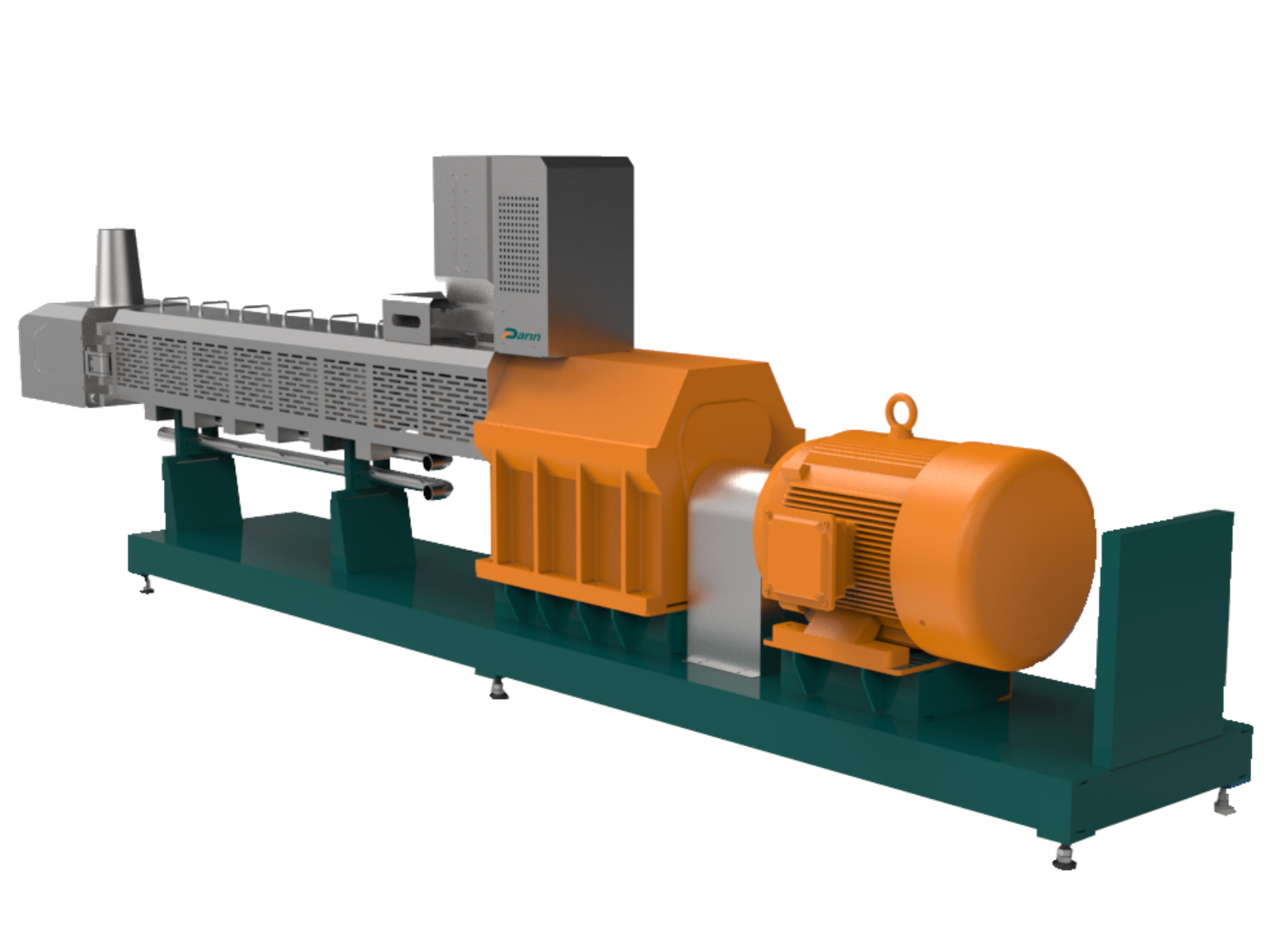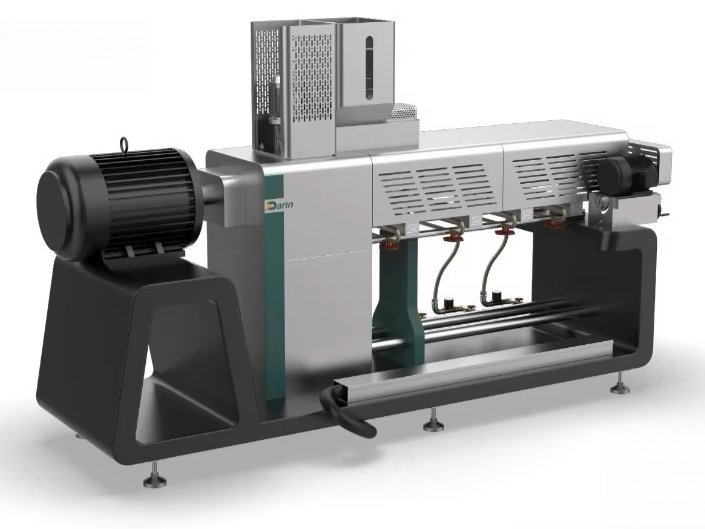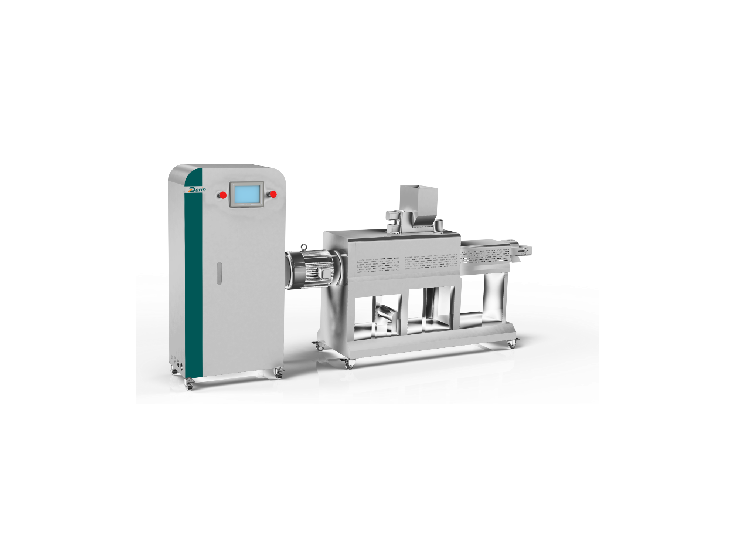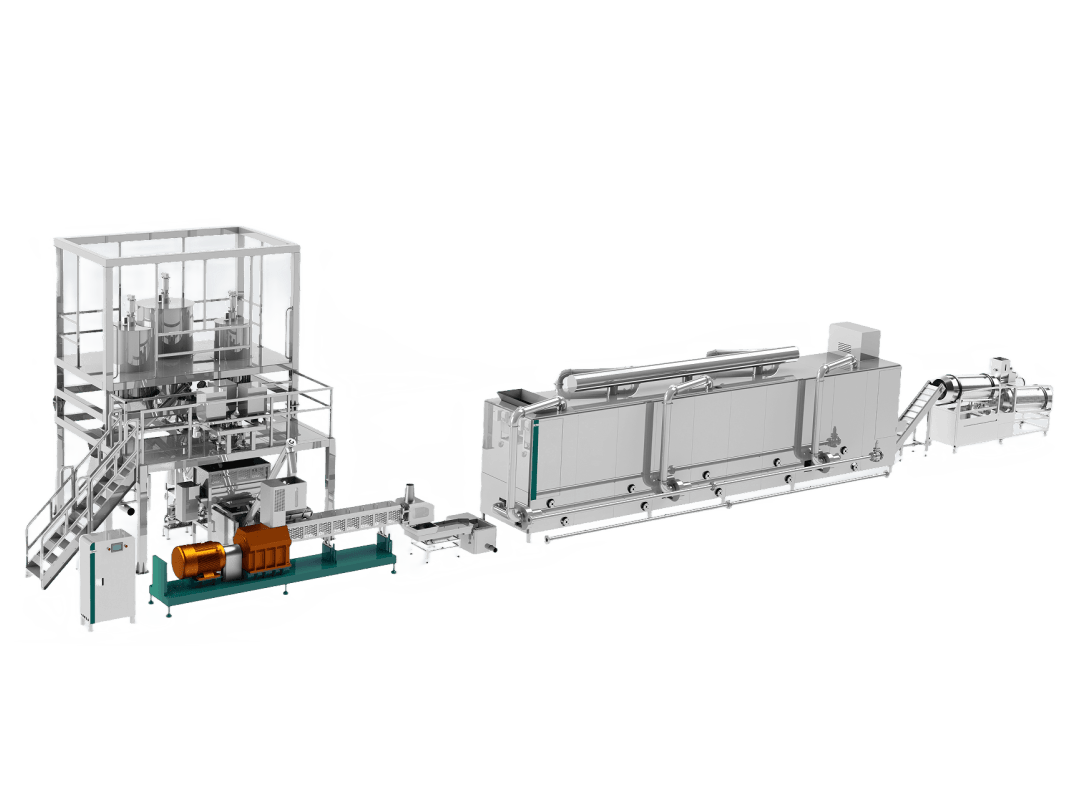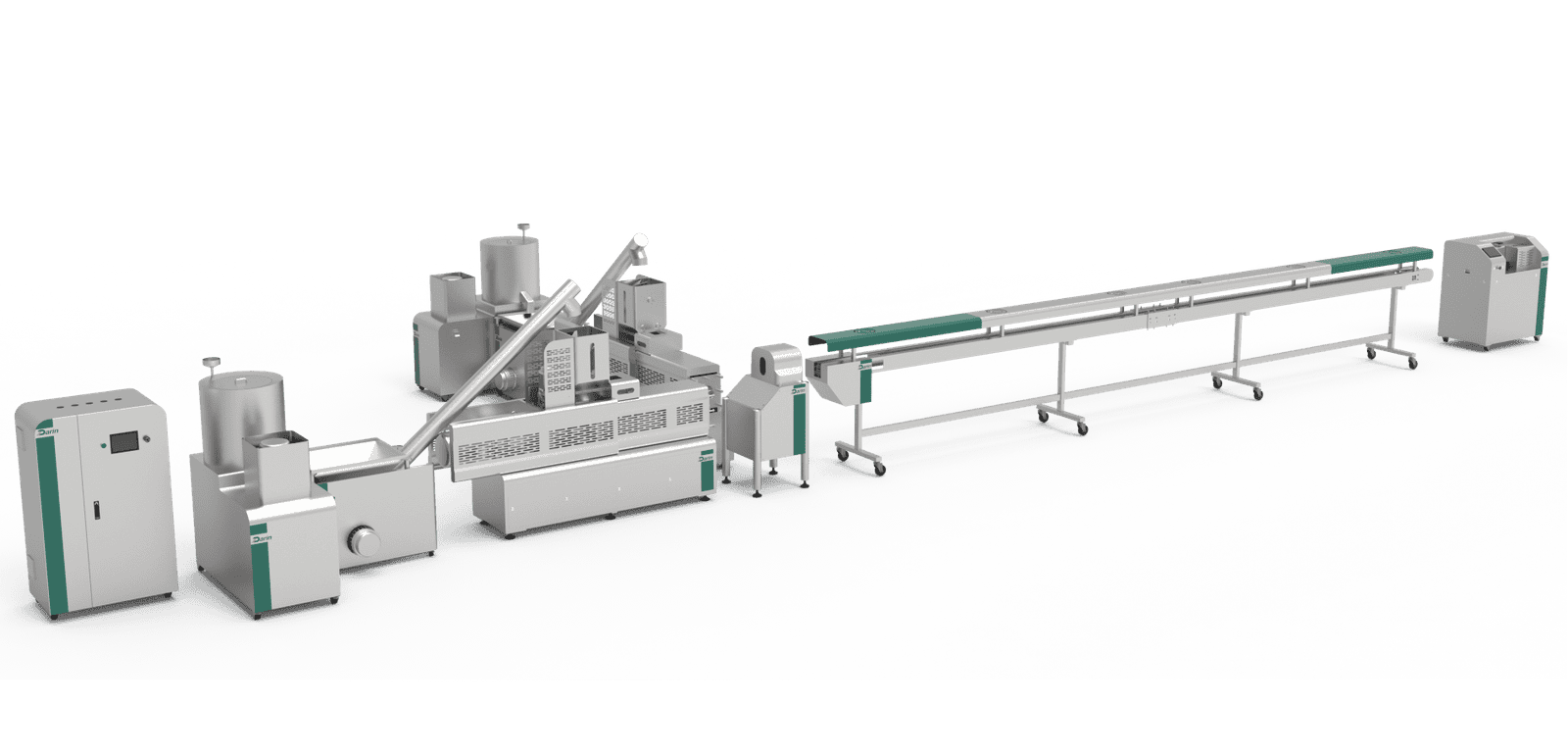
In pet nutrition manufacturing, the costliest delays usually come from two places: unpredictable product texture (snacks turn too hard, crack, or deform) and unplanned downtime (blocked dies, dryer hotspots, or coating stickiness). Both problems ripple into rejected lots, late orders, and customer complaints. The solution is a purpose-built dog snack production line engineered for stable rheology, precise moisture control, hygienic design, and closed-loop automation. As a Ph.D. process engineer and as a manufacturer at Darin Machinery, I’ll show you exactly how a modern dog snack line is specified, configured, and validated—so you can choose the right capacity, scale formulas with confidence, and hit consistent bite, shape, and shelf-life targets from day one.
A dog snack production line is a fully integrated system that converts dry and wet ingredients into shaped, dried (or fried), cooled, optionally coated, and packaged snacks through unit operations such as weighing, mixing, extrusion or forming, cutting, drying, cooling, coating, and packing—controlled by PLC/SCADA for temperature, torque, specific mechanical energy (SME), belt speed, and moisture. It works by stabilizing dough rheology (water activity and plasticity), imparting structure (gelatinization and protein denaturation), removing moisture to target a_w for shelf life, and finishing surface properties for palatability and appearance.
If you’re evaluating equipment, stick with me. Below I map the full process end-to-end, including capacity sizing, key control limits, energy and utility calculations, commissioning checklists, and a buyer’s due-diligence guide. You’ll find practical tables and formulas you can use immediately, with examples drawn from Darin Machinery pet snack lines deployed worldwide.
Dog snack lines always require twin-screw extrusion.False
Many snack formats (e.g., rotary-moulded biscuits or cold-formed jerky strips) can be produced without extrusion; extrusion is essential for certain textures but not mandatory for all.
Water activity is more critical to shelf life than final moisture percentage alone in dog snacks.True
a_w governs microbial growth and texture stability; two products with the same moisture can behave differently if a_w differs.
What counts as a “dog snack”—and why the production line differs from kibble
Dog snacks (treats) span soft-moist jerky strips, dental chews, filled co-extruded sticks, rotary-moulded biscuits, semi-moist nuggets, dehydrated meat bites, and functional chews with actives (e.g., collagen, glucosamine). Unlike dry kibble (low a_w, fragile structure optimized for expansion), snacks emphasize controlled chewiness, surface sheen, shape definition, and flavor impact at small serving sizes. The line therefore integrates shape-critical forming (dies, moulds, cold-formers), lower-temperature drying for texture, and post-dry coating for palatability—plus more frequent allergen changeovers. In practice, the “right” line is the one that locks down three variables: rheology entering the former, thermal-mass profile through drying, and a_w at packout. For example, jerky-style lines target 18–30% moisture exiting former and dry to \~20–25% with a_w 0.70–0.85 (preserved by humectants), while hard biscuit lines dry to 8–12% moisture and a_w ≤0.60.
The canonical process flow (formats covered and routing choices)
flowchart LR
A[Raw ingredient reception & QA] --> B[Weighing/Batching]
B --> C[Dry & wet mixing]
C --> D{Forming route}
D -->|Extruded| E[Twin-screw extruder + die/laminator]
D -->|Cold-formed| F[Jerky sheet former / strip cutter]
D -->|Rotary-moulded| G[Rotary moulder + oven belt]
E --> H[Pre-dryer/conditioner]
F --> H
G --> I[Continuous dryer/oven]
H --> I
I --> J[Cooling tunnel]
J --> K[Oil/flavor coating (optional)]
K --> L[Metal detection & checkweigh]
L --> M[Primary packing (FFS/flow-wrap)]
M --> N[Case packing & palletizing]This routing supports most commercial snack types. Choice of D-path dictates upstream hydration and SME targets, and downstream thermal profile.
Unit operations and what “good control” actually looks like
Weighing & batching
You need gravimetric accuracy because small absolute errors are big relative changes at snack batch sizes. ±0.2–0.5% on majors; ±0.1% on minors (salt, humectants, preservatives). We specify hygienic bins with load cells, vibratory feeders for minors, and barcode recipe verification to prevent swaps. A batching skid writes back to the MES so formulation compliance is auditable per lot.
Mixing (dry and wet)
Goal: uniform distribution and hydration without over-working proteins/starches. For jerky doughs, 6–10 minutes in a double-Z blade or ribbon mixer at 40–60% total dough moisture; for biscuit doughs, lower hydration (\~22–28%) and lower shear. Inline water temperature is a stealth variable—±3 °C swings can double viscosity drift. We recommend jacketed mixers with chilled/process-hot water manifolds and a temperature interlock.
Forming route A: Twin-screw extruder (for shaped sticks, dental chews, co-extruded filled treats)
SME (kW·h/kg) and die pressure translate to texture/expansion. We target barrel zones from 60–140 °C depending on starch gelatinization and protein set; screw speed 200–450 rpm; feed moisture 22–35% for shaped chews, 28–38% for semi-moist sticks. For co-extrusion, a secondary pump injects filling at 5–30% of product mass, synchronized to main screw speed; servo-cutter maintains length ±1.5 mm. Torque alarms protect the gearbox; automatic venting limits air pockets.
Forming route B: Cold-forming jerky (sheet & cut)
Jerky lines meter hydrated meat slurries with binders onto a lamination belt, then pass through adjustable calibrators (1.5–6 mm). Cutting uses rotary or guillotine knives synced to belt speed. Dough temperature must stay ≤16 °C to avoid smearing; jacketed hoppers and short residence times are critical.
Forming route C: Rotary-moulded biscuits
A rotary moulder transfers low-moisture dough into engraved rolls; flour dusting controls sticking. The higher fat content and lower water reduce oven load. Shape fidelity comes from dough plasticity: monitor Farinograph-like torque proxies in-line (mixer power draw vs. time).
Drying / baking
Continuous multi-pass belt dryers/ovens remove moisture to a_w setpoints without case-hardening. Typical jerky dryer: 60–95 °C, 45–120 min across 3–5 zones, RH stepped down to avoid surface sealing. Biscuit ovens: 160–220 °C, 8–20 min with color-control via top/bottom heat balance. Airflow uniformity (±10%) matters more than nameplate kW. We install pitot arrays and zone dew-point sensors to validate uniformity during FAT/SAT.
Cooling and equilibration
Don’t trap moisture—cool below 35 °C before packout. Use positive-pressure, HEPA-filtered tunnels. Equilibration spirals help moisture migrate from core to surface, stabilizing a_w. Target a core–surface a_w delta ≤0.03 before packaging.
Coating (optional)
Oil, palatant, or vitamin sprays improve acceptability but can spike rancidity risk. Use mass-flow feeders to meter oil at 0.5–4.0%; powder palatants at 0.2–2.0%. Enclose drums with solvent capture if liquid flavors include volatile carriers. Post-coat a_w must stay on spec.
Inline inspection and packing
Metal detection (ferrous ≥1.5 mm, non-ferrous ≥2.0 mm, 304 SS ≥2.5 mm for typical 250 g flow-wrap) and checkweighers (e.g., e-mark compliance) are mandatory. Choose film OTR/MVTR to match a_w: jerky needs higher barrier; biscuits tolerate slightly less. Nitrogen flushing reduces oxidative rancidity.
Key setpoints at a glance (reference table)
| Unit Operation | Typical Setpoint Window | Why It Matters | Instrumentation |
|---|---|---|---|
| Dough moisture (pre-form) | Jerky 38–50%; chews 22–35%; biscuits 22–28% | Governs plasticity and drying load | Loss-in-weight water dosing; NIR inline moisture |
| Dough temperature | 8–16 °C (jerky), 20–28 °C (biscuits) | Avoid smear; preserve shape | Jacketed mixers/hoppers; RTDs |
| Extruder SME | 0.08–0.24 kW·h/kg (chews/sticks) | Texture, expansion control | Power draw, mass flow calc |
| Dryer air temp | Jerky 60–95 °C; biscuit 160–220 °C | Pathogen lethality, texture | TCs, dew-point probes |
| Exit a_w | Jerky 0.70–0.85; biscuit ≤0.60; chews 0.60–0.75 | Shelf life | Benchtop a_w meter; inline proxy via NIR |
| Pack headspace O₂ | ≤2% (if N₂ flushed) | Rancidity control | Inline O₂ analyzer |
Ingredient systems and rheology—designing the dough for the former you choose
Rheology governs uptime: too stiff and motors over-amp; too soft and shapes slump. For jerky: meat/fish/meat-meal 20–90%, binders (starches, plant proteins) 5–25%, glycerin/sorbitol 3–12% (humectants), oil 2–6%, salt 0.5–2.0%, preservatives as allowed by local regulations, water to target. Glycerin raises density and lowers a_w but can tack up the dryer if overdosed; sorbitol improves softness but adds stickiness at high RH. Dental chews leverage starch/protein systems that set via gelatinization and protein network formation; SME acts like a cooking “currency.” For biscuits, fat shortens gluten and reduces shrink. We recommend mapping a rheology design space: moisture vs. oil vs. protein/filler; run a central-composite DOE to measure formability window and post-dry a_w. Darin’s application lab does this routinely to ensure you choose the right forming path before you buy capacity.
Automation and data: from “feel” to first-principles control
We standardize on PLC + SCADA with recipe management, OPC UA tags, and historian logging at 1–5 s resolution. Critical loops: extruder barrel zone temps, screw speed, feeder speed, cutter servo, dryer zone temp/RH/dew point, belt speeds, coating mass flow. We calculate SME on the fly (P/kgh) and alert on drift >15%. Moisture control uses feed-forward (dosing) plus feedback (NIR).
Validation tip: During commissioning, run a “golden batch” and snapshot all tags for 30 minutes in steady state; any future drift vs. that fingerprint is traceable.
Capacity sizing: a worked example for a 500 kg/h jerky line
Throughput depends on limiting unit operation—usually drying. Suppose target moisture drop is from 45% to 24% (Δm=0.21). At 500 kg/h final product, evaporate 500×0.21/0.76 ≈ 138 kg/h water (accounting for dry solid basis). With dryer latent + sensible \~2,700–3,100 kJ/kg evaporated (incl. system inefficiencies), heat duty ≈ 372–428 MJ/h (≈103–119 kW thermal). Add conveyance and losses: \~140–170 kW thermal input. Electrical: extruder/laminator 30–75 kW, fans 20–40 kW, conveyors and auxiliaries 10–20 kW. Sizing the dryer by residence time (90 min) and bulk density yields belt area; design with ≥20% turndown for seasonal RH changes.
Quick sizing reference
| Target Finished Rate | Likely Forming | Dryer Thermal Input (kW) | Total Electrical (kW) | Floor Space (m²) |
|---|---|---|---|---|
| 200 kg/h | Cold-form jerky | 60–90 | 35–55 | 90–130 |
| 500 kg/h | Cold-form or extruded | 140–170 | 60–110 | 140–220 |
| 1,000 kg/h | Often extruded | 260–330 | 110–200 | 220–350 |
| 2,000 kg/h | Multi-line | 520–660 | 220–360 | 400–650 |
Plant layout, hygiene zoning, and utilities you will actually need
Layout follows hygiene zoning: raw (RM), low-risk wet (LRW), high-risk post-lethality (HRPL), and packing (PK). Positive pressure cascades from HRPL to RM. Provide 1.2–1.5 m aisles for maintenance, and removable guarding compliant with CE. Utilities: 3-phase power (typically 380–480 V), compressed air (6–8 bar, oil-free), process water (ice/chilled for jerky), steam or thermal oil for ovens/dryers, and HVAC with dehumidification in packing to keep a_w stable. Drainage slopes 1–2%, with cleanable channels. All conveyors and frames should be open-profile to avoid harborage; welds continuous; fasteners minimized in product zone.
HACCP and prerequisite programs (with a hazard matrix you can adapt)
| Step | Biological | Chemical | Physical | Control Measures |
|---|---|---|---|---|
| Receiving | Supplier contamination | Residual solvents, allergens | Stones/metal | Approved suppliers, COAs, sieving |
| Mixing | Growth in warm slurries | Improper preservative dose | Foreign bodies | Time/Temp control, barcoding, magnets |
| Forming | None significant | Lubricant contact | Metal fragments | Food-grade lubes, metal-detect knives |
| Thermal (oven/dryer) | Pathogen lethality | Maillard byproducts at excess temp | None | Validated time/temperature; dew-point control |
| Cooling | Recontamination | None | Airborne dust | HEPA positive-pressure cooling |
| Coating | Microbial reintro | Oxidation if O₂ high | None | Filtered oils, peroxide testing, O₂ flush |
| Packing | None | Migration from film if wrong spec | Metal | Correct films, metal detection, X-ray if needed |
Cleaning, allergen control, and changeover time that won’t kill OEE
Jerky lines switch between poultry, beef, and fish; biscuits flip between peanut-containing and free. Validate dry-clean plus foam-in-place for open conveyors, COP tanks for small parts, and ATP + allergen swabs at worst-case harborage points (knife hubs, die plates, drum vanes). Engineer CIP where feasible (coating lines, enclosed extruder barrels). Design target: major allergen changeover ≤6 h; flavor-to-flavor ≤2 h. OEE often jumps 5–12 points after you standardize changeover with visual work instructions and 5S kitting.
Energy, emissions, and sustainability levers that also pay back
Big wins: heat recovery from dryer exhaust (plate heat exchangers or run-around coils), variable-speed fans, dew-point control instead of simple temperature ramps, and N₂ on-demand generation (PSA) with load following. Capturing 20–30% exhaust sensible heat can shave 10–15 kW off a 500 kg/h line. Specify IE3/IE4 motors and premium belts; synchronize shutdown so dryers ramp down, not crash, to prevent thermal shock and cracked product.
Cost model, TCO, and ROI (with realistic ranges)
CapEx depends on capacity and forming route. A compact 200 kg/h cold-form jerky line with dryer, cooler, and packer may run USD 280–450k. A 500 kg/h line with more automation and N₂ pack may be USD 650k–1.2 m. Extruded dental-chew lines add extruder, cutter, and co-ex units: 1.1–2.0 m for 500–1,000 kg/h. OpEx drivers: labor (operators + QC), energy (thermal + electrical), maintenance (2–4% of CapEx per year), packaging materials, and palatants (can be >30% of unit cost on premium snacks). Simple ROI: if a 500 kg/h line running 16 h/day at \$0.70/kg gross margin yields \~\$5,600/day, annualized margin \~\$1.9 m; even at 60% uptime in year one, payback can land within 12–24 months depending on CapEx and SG\&A allocation.
A compact troubleshooting guide (symptom → root causes → fix)
| Symptom | Likely Causes | Fix Fast | Fix Permanently |
|---|---|---|---|
| Shapes slump after forming | Dough too warm/wet, fat smear | Chill hopper; reduce water 1–2%; add binder | Jacket hopper; tighter water temp control; reformulate plasticizer ratio |
| Jerky sticky in dryer | Excess humectant, RH too high | Reduce glycerin 1–2%; open bypass; increase air velocity | Rebalance humectants; dew-point control; add pre-dryer zone |
| Dental chew too hard | SME too high, over-dry | Lower screw speed or torque; raise exit moisture | Re-profile screws; adjust die land; tune dryer curve |
| Surface cracks | Case-hardening | Lower first-zone temp; raise RH | Add zoned RH control; lengthen residence time |
| Rancid notes at 3 months | High headspace O₂, oil quality | Increase N₂ flush; switch oil batch | Higher-barrier film; peroxide monitoring; antioxidants per regulation |
Preventive maintenance schedule you can lift into your CMMS
| Frequency | Tasks (examples) |
|---|---|
| Per shift | Inspect belts and guards, verify critical sensors (temp, RH, torque), clean visible residues, a_w spot-checks |
| Weekly | Lubricate bearings (food-grade), check cutter blades, verify metal detector performance, calibrate weighers |
| Monthly | V-belt tensioning, thermal camera scan of MCCs, CIP validation, NIR/moisture meter calibration |
| Quarterly | Extruder screw/barrel wear check, dryer airflow balance, safety interlock tests, historian data health check |
| Annually | Overhaul gearboxes, replace wear liners and die inserts, rebuild pumps/valves, full HACCP verification & training |
Commissioning, FAT/SAT, and validation—how to get to spec quickly
At Darin Machinery we run a formal FAT: mechanical/electrical checks, I/O list verification, recipe downloads, empty-belt thermal mapping, and witnessed safety tests. Then wet FAT with your ingredients to produce a “golden batch.” SAT repeats critical tests after install. Process validation includes: (1) lethality study or proxy validation for target products, (2) moisture/a_w capability study over 30 lots, (3) packaging stability at 25 °C/60% RH (or your market conditions), and (4) allergen changeover validation. We hand over a tagged historian and a “first 90 days” playbook.
Selecting a supplier: a practical RFP checklist
- Formats and capacities you must cover in year 1 and year 3
- Hygienic design features (open profiles, weld types, surface finishes, materials certificates)
- Automation stack and openness (PLC brand, SCADA, OPC UA tag dictionary, historian ownership)
- Changeover aids (tool-less belts, quick-release dies, visual work instructions)
- Thermal uniformity guarantees in kW and ±% airflow
- Moisture/a_w control strategy (inline NIR? feedback logic?)
- Validation support (FAT/SAT test plans, golden batch definition)
- After-sales service (SLA response times, spare parts list, remote support capability)
Case snapshot: a 1,000 kg/h multi-format line
A client needed jerky strips, co-extruded filled sticks, and hard biscuits on one footprint. We provided two forming routes (cold-form + twin-screw) feeding a shared 3-pass dryer with zoned RH, then a common cooling/inspection/packing spine. Result: 18 SKUs with median changeover 2.2 h flavor-to-flavor, 6.5 h allergen-to-allergen. OEE rose from 58% at start-up to 73% in 90 days after DOE-driven parameter mapping and preventive maintenance standardization.
What makes a Darin Machinery line different in daily use
As both designer and OEM, our playbook is pragmatic: we design for maintainability (lift-off guards, open frames), for control (dew-point and air velocity sensors standard), and for scale (modular dryer decks, extruder barrel sections). Our applications lab will: (1) characterize your formulas, (2) select forming route and SME/a_w targets, (3) prove texture profile analysis vs. competitor benchmarks, and (4) deliver a documented startup curve so operators know what “good” feels like. That’s how you hit spec with less trial-and-error.
Frequently asked questions (short, actionable answers)
- Can one line make jerky and dental chews? Yes, with dual forming paths or tool-less swap-outs, provided the dryer is sized for the worst-case moisture removal.
- How do I prevent case-hardening? Start with higher RH/air velocity and step down temperature; control dew point, not just dry-bulb.
- What’s the most overlooked variable? Dough temperature at the former; ±3 °C can make or break shape fidelity.
- How do I size packaging barrier? Base MVTR/OTR on a_w and oil load; validate with headspace O₂ targets ≤2% for coated products.
- What is a realistic payback? Often 12–24 months at mid-scale if utilization exceeds 60% and you control palatant costs.
A quick buyer’s worksheet (fill-in)
- Product formats (top 3 by volume): ______ / ______ / ______
- Target capacities (kg/h now; 3-year): ______ → ______
- Forming route candidates: Extrusion / Cold-form / Rotary-moulded
- Target a_w at packout: ______
- Changeover constraints (allergen? time limit?): ______
- Packaging format and film barrier: ______
- Utilities available (power, steam/thermal oil, N₂): ______
Parting thoughts
If you remember only three things, make them these: (1) pick the forming route that fits your rheology and SKU roadmap, not the other way around; (2) control dew point and airflow in the dryer, and a_w will follow; (3) design changeover into the line—your true throughput is what you run between cleanings, not what’s printed on a spec sheet. With that mindset, a dog snack line becomes a predictable profit engine, not a daily experiment.
Ready to design your line together?
If you want a practical, no-nonsense plan—formulas characterized, line sized, and commissioning mapped—reach out. We’ll talk real constraints, real numbers, and build a line you can scale without drama.
Talk to Darin Machinery
Email: darin4@darin.cn
Website: https://petreatsmachine.com/
Tell us your top three SKUs, target capacity, and changeover constraints, and we’ll sketch the line and a first-month startup curve you can actually run with.


